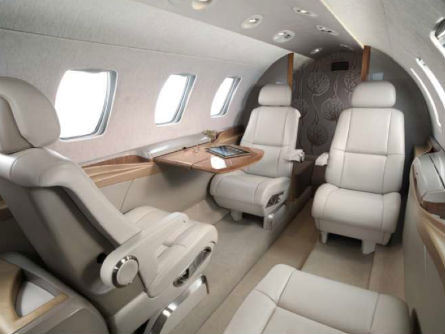Cessna has revealed a "new" Citation family light business jet that spans the gap between the $3.1 million Mustang and $7 million CJ2+.
Called the M2, the Williams International FJ44-powered twinjet started life during former Cessna chief Jack Pelton's tenure when engineers had been quietly working to give Mustang operators what they had been asking for - a faster, larger transition aircraft with a more private lavatory, says Mark Paolucci, senior vice-president of sales at Cessna. The aircraft was to be a bridge between the Mustang and the CJ2+, currently the next model up from the Mustang.
|
|
|---|
| © Cessna |
While engineers had originally started with a clean sheet design for the aircraft, the company more recently decided "we had a basic design already that would give what we were asking for," says Paolucci. What resulted was a "tweak" to the CJ1 (Model 525), now out of production. "We stayed in the same space and went back to an existing model to make some changes," says Paolucci. "We're happy with the results: It's less expensive than the CJ1 and will help us in the market."
Cessna revealed the tweaked aircraft on 26 September in Wichita. The eight-seat M2 features a 400kt maximum cruise speed and will carry two more passengers than the Mustang - one in the co-pilot seat, one on a forward side-facing seat at the front of the cabin, four in club seating mid-cabin and one on a belted lavatory at the back of the cabin. Cessna selected the Garmin 3000 integrated avionics system packaged as a Cessna Intrinzic flight deck. The initial price is $4.195 million.
| Cessna M2 high level specifications | |
|---|---|
| Price | $4.195 M |
| EIS | 3Q 2013 |
| MTOW (lb) | 10,700 |
| Seats | 1 + 7 |
| Engines | 2 x Williams FJ44 |
| Max cruise (kt) | 400kt |
| Max alt (ft) | 41,000 |
| Time to climb (min) | 24 |
| Range (NBAA IFR, nm) | 1,300 |
Powered by two Williams International FJ44-1AP-21 engines each producing 1,965lb-thrust, the M2 will climb to 41,000ft in 24 minutes where it will have a maximum cruise speed of 385kt. The M2 will top out at 400kt at 33,000ft. NBAA IFR range is 1,300nm. The -1AP-21 is a new variant of the FJ44.
With full fuel of 3,309lb, the M2 will have a payload of 500lb. Maximum takeoff weight is 10,700lb.
The FADEC-controlled engines will have a 2,000h inspection interval and 4,000h TBO, the same as the Mustang. Fuel will be heated internally, eliminating the need for anti-ice additive.
Construction will be all aluminium, with a T-tail and straight wings capped with Cessna's first in-house production winglets, says Michael Pierce, Cessna director of product marketing. "They're pretty basic winglets," says Pierce. "We've proven they've done well on Citation X, now we're starting to look at winglets for other airframes."
Certified for single pilot operations, the M2 cockpit will feature three Garmin 14.1in liquid crystal displays with two centre console Garmin GTC 570 touch screen controllers that interface with the flight management system.
|
|
|---|
| © Cessna |
Flight controls are the traditional mechanical type. Pierce says auto throttles are not an option for the M2. "Too expensive for this class of aircraft," he says. A head-up display (HUD) is not an option initially; though he says a HUD could potentially be an option later. Garmin's synthetic vision (SV) is an option, not standard equipment. "We have enough people that don't ask for [SV] all the time," says Pierce. "Customers want the ability to select it."
Pierce says Cessna is "still looking into" an automatic descent mode (for decompression problems) for Intrinzic, but says there will not be an automatic aircraft attitude recovery mode, a trademark feature of Garmin's lower end avionics suites.
Standard equipment will include a Garmin GFC 700 autopilot, TAWS B, TCAS1, XM graphical weather, Garmin's weather radar and ADS-B out. Along with synthetic vision, options include a cockpit voice recorder and broadband for the cabin.
Pierce says the customer will have selections for the interior, which he says has "styling completely different than anything else we've ever done", including on-purpose cavities for personal electronics like mobile phones. A cabin management system (CMS) by Heads Up Technologies, the CMS provider for the Citation Ten, will be optional.
|
|
|---|
| © Cessna |
Cessna expects to power on the first prototype in December, with first flight following in the first quarter of 2012. Certification testing is expected to start in the third quarter of 2012 with one aircraft only. Production flow will start in the third quarter as well. Pierce says the production line will either be in Wichita or at Cessna's Independence, Kansas, facility. "We don't need to build new facilities for this one," he adds. He says the company is hiring engineers but he was not sure if more production workers would be needed for the M2.
Pierce expects Williams to certify the engine variant in the first quarter of 2013, with US Federal Aviation Administration (FAA) type certificate for the M2 following in the second quarter. Cessna is slating third quarter 2013 for entry into service (EIS).
Paolucci says the name M2 came as a result of "talking to employees in the factory" who wanted "something young" to title the business jet. "I think M2 will make a strong statement in the market," he says.
Source: Flight International



















